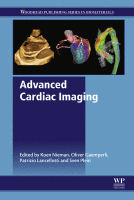Physical Address
304 North Cardinal St.
Dorchester Center, MA 02124

12.1 Introduction Heart failure (HF) is a growing problem worldwide. Almost 6 million Americans and 15 million Europeans have HF [ , ]. Normal ventricular function requires coordinated electrical activation and contraction but also appropriate pre- and after-loads. Given the…

Acknowledgements The authors would like to thank The Royal Brompton Hospital CMR Unit, Dr Stephan Nekolla, Dr Filip Zemrak, and Dr Navtej Chahal for assistance with images. 11.1 Background, terms, and definitions 11.1.1 Introduction With advancing technology, non-invasive imaging has…

10.1 Introduction Acute myocardial infarction (MI) is defined as death of the myocytes (myocardial necrosis) in a clinical setting consistent with acute myocardial ischemia [ ]. Echocardiography, nuclear imaging techniques, CMR, and CT play an important role in detecting and…

Abbreviations BOLD blood–oxygen-level-dependent CAD coronary artery disease CFR coronary flow reserve CTCA computed tomography coronary angiography ECHO echocardiography FFR fractional flow reserve ICA invasive coronary angiography IHD ischemic heart disease IVUS intravascular ultrasound MR magnetic resonance MRA magnetic resonance imaging…

8.1 Introduction Atherosclerosis is a chronic inflammatory disease [ ]. Although great strides have been made in the diagnosis and management of atherosclerotic cardiovascular disease (CVD), overall mortality due to underlying atherosclerosis remains a leading cause of death in industrialized…

7.1 Introduction Invasive coronary angiography (ICA) is the gold standard for the identification of anatomically obstructive coronary artery disease (CAD). However at many centers, ICA is a limited resource that is expensive and has periprocedural risks (death, cerebrovascular accident, myocardial…

Acknowledgments The authors of this chapter acknowledge BioMed Central as the original publisher of selected figures in this chapter as indicated by references to the original authors and publications. The authors also acknowledge Oxford University Press as the original publisher…

5.1 Development of cardiac CT In 1972, the first CT scanner was designed by the engineer Geoffrey N. Hounsfield at an English company named EMI Ltd. Together with Allan C. Cormack, a physicist from Cape Town who developed the mathematical…

3.1 Introduction Radionuclide imaging today is an active and growing branch of medical diagnostics. Over the past decades, radionuclide imaging has advanced to become a cornerstone for the accurate diagnosis and appropriate management of a variety of medical conditions. Interestingly,…

2.1 Introduction The traditional echocardiographic techniques are widely used and form a routine complete echocardiographic examination: – M-mode recordings, guided by two-dimensional (2D) echocardiographic images, are used for quantification of cardiac dimension and timing of rapid cardiac motions [ ].…